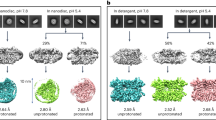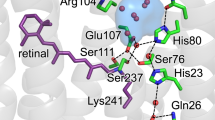Abstract
RECOVERIN, a retinal calcium-binding protein of relative molecular mass (Mr) 23K, participates in the recovery phase of visual excitation and in adaptation to background light1–3. The C a2 +-bound form of recoverin prolongs the photoresponse4, probably by blocking phosphorylation of photoexcited rhodopsin5. Retinal recoverin contains a covalently attached myristoyl group or related acyl group at its amino terminus6 and two Ca2+ -binding sites7. Ca2+ binding to myristoylated, but not unmyristoylated, recoverin induces its translocation to bilayer membranes, indicating that the myristoyl group is essential to the read-out of calcium signals (calcium-myristoyl switch)8,9. Here we present the solution structure of Ca2+-free, myristoylated recombinant recoverin obtained by heteronuclear multidimensional NMR spectroscopy. The myristoyl group is sequestered in a deep hydrophobic pocket formed by many aromatic and other hydrophobic residues from five flanking helices.
This is a preview of subscription content, access via your institution
Access options
Subscribe to this journal
Receive 51 print issues and online access
$199.00 per year
only $3.90 per issue
Buy this article
- Purchase on Springer Link
- Instant access to full article PDF
Prices may be subject to local taxes which are calculated during checkout
Similar content being viewed by others
References
Stryer, L. J. biol. Chem. 266, 10711–10714 (1991).
Koch, K.-W. Rev. Physiol. Biochem. Pharmac. 125, 149–192 (1994).
Dizhoor, A. M. et al. Science 251, 915–918 (1991).
Gray-Keller, M. P., Polans, A. S., Palczewski, K. & Detwiler, P. B. Neuron 10, 523–531 (1993).
Kawamura, S., Hisatomi, O., Kayada, S., Tokunaga, F. & Kuo, C.-H. J. biol. Chem. 268, 14579–14582 (1993).
Dizhoor, A. M. et al. J. biol. Chem. 267, 16033–16036 (1992).
Ames, J. B., Porumb, T., Tanaka, T., Ikura, M. & Stryer, L. J. biol. Chem. 270, 4526–4533 (1995).
Zozulya, S. & Stryer, L. Proc. natn. Acad. Sci. U.S.A. 89, 11569–11573 (1992).
Dizhoor, A. M. et al. Science 259, 829–832 (1993).
Babu, Y. S., Bugg, C. E. & Cook, W. J. J. molec. Biol. 24, 191–204 (1988).
Herzberg, O. & James, M. N. G. J. molec. Biol. 203, 761–779 (1988).
Zheng, J. et al. Protein Sci. 2, 1559–1573 (1993).
Chow, M. et al. Nature 327, 482–486 (1987).
Ames, J. B., Tanaka, T., Stryer, L. & Ikura, M. Biochemistry 33, 10743–10753 (1994).
Yamagata, K., Goto, K., Kuo, C.-H., Kondo, H. & Miki, N. Neuron 2, 469–476 (1990).
Kobayashi, M., Takamatsu, K., Saitoh, S. & Noguchi, T. J. biol. Chem. 268, 18898–18904 (1993).
Ladant, D. J. biol. Chem. 270, 3179–3185 (1995).
Kuno, T. et al. Biochem. biophys. Res. Commun. 184, 1219–1225 (1992).
Resh, M. D. Cell 76, 411–413 (1994).
Flaherty, K. M., Zozulya, S., Stryer, L. & McKay, D. B. Cell 75, 709–716 (1993).
Helms, J. B., Palmer, D. J. & Rothman, J. E. J. Cell Biol. 121, 751–760 (1993).
Kim, J., Shishido, T., Jiang, X., Aderem, A. & McLaughlin, S. J. biol. Chem. 269, 28214–28219 (1994).
Michel, T., Li, G. K. & Busconi, L. Proc. natn. Acad. Sci. U.S.A. 90, 6252–6256 (1993).
Walker, F., deBlaquiere, J. & Burgess, A. W. J. biol. Chem. 268, 19552–19558 (1993).
Nilges, M., Gronenborn, A. M., Brünger, A. T. & Clore, G. M. Protein Engng 2, 27–38 (1988).
Brünger, A. T. X-PLOR Version 3.1: A System for x-ray Crystallography and NMR (Yale Univ.Press, New Haven, 1993).
Bagby, S., Harvey, T. S., Eagle, S. G., Inouye, S. & Ikura, M. Structure 2, 107–122 (1994).
Kraulis, P. J. J. appl. Crystaltogr. 24, 946–950 (1991).
Kobayashi, M., Takamatsu, K., Saitoh, S., Miura, M. & Noguchi, T. Biochem. biophys. Res. Commun. 189, 511–517 (1992).
Okazaki, K. et al. Biochem. biophys. Res. Commun. 185, 147–153 (1992).
Pongs, O. et al. Neuron 11, 15–28 (1993).
Ferrin, T. E., Huang, C. C., Jarvis, L. E. & Langridge, R. J. molec. Graph. 6, 13–27 (1988).
Author information
Authors and Affiliations
Rights and permissions
About this article
Cite this article
Tanaka, T., Amest, J., Harvey, T. et al. Sequestration of the membrane-targeting myristoyl group of recoverin in the calcium-free state. Nature 376, 444–447 (1995). https://doi.org/10.1038/376444a0
Received:
Accepted:
Issue Date:
DOI: https://doi.org/10.1038/376444a0
This article is cited by
-
Protein N-myristoylation: functions and mechanisms in control of innate immunity
Cellular & Molecular Immunology (2021)
-
Biochemistry and physiology of zebrafish photoreceptors
Pflügers Archiv - European Journal of Physiology (2021)
-
Functional compartmentalization of photoreceptor neurons
Pflügers Archiv - European Journal of Physiology (2021)
-
N-myristoylation: from cell biology to translational medicine
Acta Pharmacologica Sinica (2020)
-
Crystal structure of a Ca2+-dependent regulator of flagellar motility reveals the open-closed structural transition
Scientific Reports (2018)
Comments
By submitting a comment you agree to abide by our Terms and Community Guidelines. If you find something abusive or that does not comply with our terms or guidelines please flag it as inappropriate.



